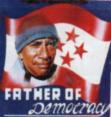 With that massive showdown looming, the wild card is obviously Kathmandu Valley’s Newars. Their turnout – or lack of it -- will determine which side wins. Ever since the first phase of King Gyanendra’s takeover on October 4, 2002, the mainstream political parties have been trying hard to replicate the flavor and feistiness of the Jana Andolan. The democracy movement has gone through different phases but hasn’t been able to acquire enough firepower to intimidate the palace. Why? A principle reason is that Newars aren’t too thrilled.
With that massive showdown looming, the wild card is obviously Kathmandu Valley’s Newars. Their turnout – or lack of it -- will determine which side wins. Ever since the first phase of King Gyanendra’s takeover on October 4, 2002, the mainstream political parties have been trying hard to replicate the flavor and feistiness of the Jana Andolan. The democracy movement has gone through different phases but hasn’t been able to acquire enough firepower to intimidate the palace. Why? A principle reason is that Newars aren’t too thrilled.When the capital last erupted, Newars were at the forefront of the thunder and lightning. It was the Nirgun Sthapits and Soviet Man Shresthas who fell to the cause of democracy. The old quarters of Patan became an autonomous republic. During those days, most Newars seemed ready to avenge everything starting from Prithvi Narayan Shah’s blood-drenched conquest of the valley.
Newars became among the first to be disenchanted. Ganesh Man Singh’s wife and son, who had made enough of their own mark on the democracy struggle to qualify as election candidates, became the first victims of the bramhu-chas ascendant in the Nepali Congress. Marshal Julum Shakya, that youthful face of anti-Panchayat defiance, had already been edged out. In no time, the supreme commander of the democracy movement, had been portrayed by his peers as a grumpy malcontent carrying virulent strains of communalism. Even the worst enemies of Ganesh Man Singh knew those attributes to be untrue.
Despite all the ideological symbolism involved, the Krishna Prasad Bhattarai-Madan Bhandari contest was merely a harbinger of the caste-hierarchy-based haughtiness of the new political class. Soon people who clearly belonged to constituencies outside the valley became candidates in growing numbers.
At one level, the comrades were perhaps more deserving. Many had married into Newar families during their underground years. That intricate network shielded most from the clutches of Panchayat totalitarians. Once the light of democracy shone, it became clear that the comrades already had wives and children in the eastern hills and plains.
The Nepals, Pokharels, Bajgains and Pants weren’t the candidates too many Newars expected to rise from the Panchayat debris. (The Maobadis aren’t quite different on this count. The first thing the two brahmus do after patching up is expel Rabindra Shrestha and another leading rebel.)
What’s there to throng the streets and dodge the bullets for if the choice for Asan voters under Democracy III would be among, say, Mandals, Tumbahamphes and Bohras?
And, yes, I heard you. Who am I to complain?